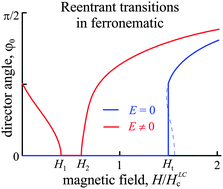Interplay between dipole and quadrupole modes of field influence in liquid-crystalline suspensions of ferromagnetic particles
Abstract
In the framework of continuum theory we study orientational transitions induced by electric and magnetic fields in ferronematics, i.e., in liquid-crystalline suspensions of ferromagnetic particles. We have shown that in a certain electric field range the magnetic field can induce a sequence of re-entrant orientational transitions in the ferronematic layer: nonuniform phase–uniform phase–nonuniform phase. This phenomenon is caused by the interplay between the dipole (ferromagnetic) and quadrupole (dielectric and diamagnetic) mechanisms of the field influence on a ferronematic structure. We have found that these re-entrant Freedericksz transitions exhibit tricritical behavior, i.e., they can be of the first or the second order. The character of the transitions depends on a degree of redistribution of magnetic admixture in the sample exposed to a uniform magnetic field (magnetic segregation). We demonstrate how electric and magnetic fields can change the order of orientational transitions in ferronematics. We show that electric Freedericksz transitions in ferronematics subjected to magnetic field have no re-entrant nature. Tricritical segregation parameters for the transitions induced by electric or magnetic fields are obtained analytically. We demonstrate the re-entrant behavior of ferronematics by numerical simulations of the magnetization and optical phase lag.


 Please wait while we load your content...
Please wait while we load your content...